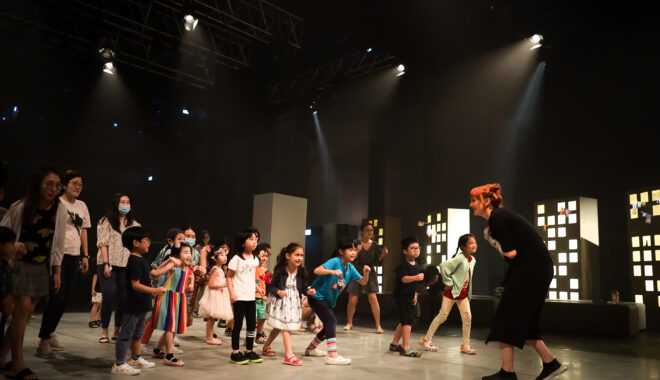23 Aug 2018
Child’s Story – messages from behind the curtain
REVIEW – Cerita Anak (Child’s Story), The Jakarta Post, Wednesday 9 May 2018
Written by Tarko Sudiarno
Behind a translucent curtain shaped like a square aquarium, a group of children move freely like they are enjoying a completely new experience: being taken into an unpredictable sea adventure.
That was a scene from Child’s Story, a show performed by Papermoon Puppet Theater, conducted in collaboration with Polyglot Theatre from Australia at Padepokan Seni Bagong Kussudiardja (PSBK) in Yogyakarta, as part of ARTJOG 2018’s special performance.
Maria Tri Sulistyani of Papermoon said the show’s theme was taken from the maritime history of Lasem, Central Java, combined with true story of a Sri Lankan child seeking asylum in Australia. “For Australian audiences, it’s like the story of boat people seeking asylum in Australia. For Indonesian spectators, they feel like they’re being taken on an adventure on board a boat to a new world,” said Maria, or Ria Papermoon as she is popularly known.
For the performance, the concept differed from the one performed in Australia last year, where the audience was limited to only 40, and in which audience members played a part in the story by joining the boat adventure.
In Yogyakarta, Ria said the audience was divided into two. The first group was the main audience, which comprised 40 children along with their companions, while the other group comprised 150 audience members placed outside the curtain. But the story remains the same. The first group behind the curtain on the boat did not realize there was an audience outside, and they moved and acted as they liked while “inside” the aquarium.
The play started with children arriving through a special door in the back part of the contemporary stage. There, they found the front half of a boat (made of cloth) along with its mast and wooden steering wheel. To make the children feel like they were at sea, they played with small boats and waves, which were also made of cloth.
They were then escorted to board the boat. Slowly, three main actors, who were acting as the boat’s crew, started to move the boat by releasing the anchor and opening the sail. Thanks to the lighting and stage effects, it appeared as though the boat was really moving.
The sense of a moving boat was not just felt by the passengers onboard but also by the static audience watching the show from in front of the curtain.
When the wave was at high tide and the boat floated high, the passengers cried out as if the waves were really rocking the vessel. When the seawater was calm, similarly, they looked as if they wanted to fish and enjoy life on the ocean.
Suddenly their adventure became tense. The sky promptly turned dark, followed by storms and heavy rain. The boat appeared to sink into the darkness of an undersea world. The passengers fell silent, anticipating the unknown.
It was at this time that the sea world started to convey messages. The ship’s walls then turned into a big screen depicting the beautiful and amazing possibilities of the undersea world, displayed through shadow plays from four projectors reflected on the ship’s wall.
The children started to enjoy the magical ambience through lighting plays depicting a starry night, describing hopes in nature. All of a sudden they arrived on a beautiful island full of hope. Ria said the ending of the story presented in Indonesia was made to make the children as well as the audience outside the curtain happy.
“When in Australia, many of the audience members could not hold back their tears. Maybe they were very sensitive watching the uncertain fate of the boat people,” Ria said.
The show, Child’s Story, despite using simple means, was successful in taking the audience’s imagination to a marine world. For the whole three days over last weekend, full crowds attended the performances.
Ria said the performance brought in a different kind of theater show for children. “There is a layer that can be easily enjoyed by children, and then there is a deep meaning that can be grasped by adults.”
Photograph: Indra Wicaksono
- Polyglot Theatre Admin
Yogyakarta







